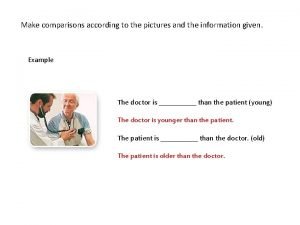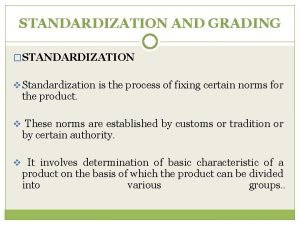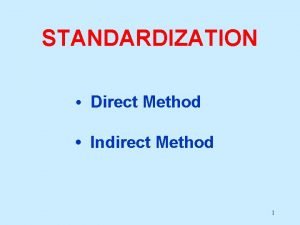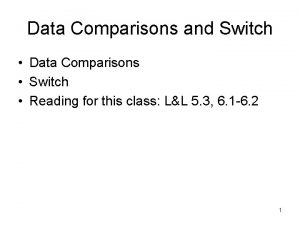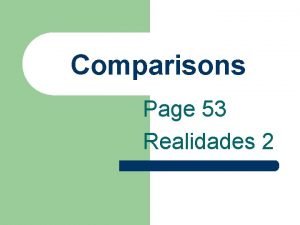4 Rates and Standardization Rates To make comparisons
















- Slides: 16


4 Rates and Standardization

Rates To make comparisons among groups more meaningful, rates may be used instead of raw numbers. Rate = the number of cases of a particular outcome of interest that occur over a given period of time / the size of the population in that time period Infant mortality rate = number of deaths during a calendar year among infants under one year of age / the total number of live births during that year (unit = per 1000 live births) Chapter 4 p 67

Figure 4. 1 Trends in the crude marriage and divorce rates, USA, 1950 -1994. Chapter 4 p 70

Standardization of rates Hearing impairment due to injury reported by individuals 17 years of age and older in 1980 -1981 Employment status Population Impairments Rates per 1000 Currently employed 98917 552 5. 58 Currently unemployed 7462 27 3. 62 Not in the labor force 56778 368 6. 48 163157 947 5. 80 Total Currently employed Not in the labor force Age Population % 17 – 44 67987 68. 7 20760 36. 6 45 – 64 27592 27. 9 15108 26. 6 65+ 3338 3. 4 20910 36. 8 Total 98917 100 56778 100 It appears that individuals who are not in the labor are at greater risk of hearing impairment due to injury than those who are currently employed. = 947/163157 Age group Differ in age composition individuals not included in the labor force are older than those who are currently employed

Age-specific impairment rates in the surveyed population as a whole Age Population Impairments Rates per 1000 17 – 44 94930 441 4. 65 45 – 64 43857 308 7. 02 65+ 24370 198 8. 12 Total 163157 947 5. 80 = 441/94930 Age-specific impairment rates for the two subpopulations, Currently employed and Not in the labor force Currently employed Not in the labor force Age Population impairments Rate per 1000 17 – 44 67987 346 5. 09 20760 80 3. 85 45 – 64 27592 179 6. 49 15108 117 7. 74 65+ 3338 27 8. 09 20910 171 8. 18 Total 98917 552 5. 58 56778 368 6. 48 = 80/20760 How many impairments in the age group 17 -44, 45 -64, and 65+ for the currently unemployment subpopulation? 15, 12, 0

Direct method of standardization Expected age-specific impairment rates for the two subpopulations, using Currently employed rate per 1000 and Not in the labor force rate per 1000 Total Currently employed Not in the labor force Age (1) Population (2) Rate per 1000 (3) Expected impairments (4) Rate per 1000 (5) Expected impairments 17 – 44 94930 5. 09 483. 2 3. 85 365. 5 45 – 64 43857 6. 49 284. 6 7. 74 339. 5 65+ 24370 8. 09 197. 2 8. 18 199. 3 Total 163157 965. 0 6. 48 904. 3 (3) = (1) x (2)/1000 (5) = (1) x (4)/1000 Age-adjusted impairment rates for the Currently employed and Not in the labor force Currently employed : 965. 0/163157 = 5. 91 per 1000 Not in the labor force : 904. 3/163157 = 5. 54 per 1000 After we control for the effect of age, impairment rates for the currently employed > impairment rate not in the labor force opposite of what we observed when we looked at the crude rates influenced by the age structure

Indirect method of standardization Expected age-specific impairment rates for the two subpopulations, using Currently employed rate per 1000 and Not in the labor force rate per 1000 Total Currently employed Not in the labor force Age (1) Rate per 1000 (2) Population (3) Expected impairments (4) Population (5) Expected impairments 17 – 44 4. 65 67987 316. 1 20760 96. 5 45 – 64 7. 02 27592 193. 7 15108 106. 1 65+ 8. 12 3338 27. 1 20910 169. 8 98917 536. 9 56778 372. 4 Total surveyed population rate (3) = (1) x (2)/1000 (5) = (1) x (4)/1000 Currently employed : 552/536. 9 = 1. 03 Not in the labor force : 368/372. 4 = 0. 99 The currently employed individual has a 3% higher impairment rate than the surveyed population Those not in the labor force individual has a 1% lower Direct method of standardization is used more often than the indirect method.

Vertical bars = change in disease classification The standardized rates were calculated by means of the direct method the US population in 1940 The adjusted rates have been decreasing for the most part except the HIV death rate. HIV – a new disease Chapter 4 p 77

Subgroup death rates for men and women Figure 4. 3 Death rates from leading causes of death for men and women 25 to 44 years of age, USA, 1982 -1992 Chapter 4 p 82

Direct method of standardization subgroup-specific rates should have the same general trends in all groups being compared, as shown in Fig. 4. 4(a) such as calendar years, age Chapter 4 p 83

A somewhat less ideal situation occurs when the trends are not parallel such as calendar years, age Chapter 4 p 83

The subgroup-specific rates follow very different patterns in the two populations, Direct method of standardization should not be attempted. such as calendar years, age Chapter 4 p 83

The graph most closely resembles Fig. 4. 4(b) direct method of standardization is appropriate to use Chapter 4 p 84

Applications Chapter 4 p 87

Exercise Chapter 4 p 66
 Pictures to make comparisons
Pictures to make comparisons Comparatives cold
Comparatives cold Quantifiers to make comparisons
Quantifiers to make comparisons A rate is a ratio
A rate is a ratio Equivalent ratios
Equivalent ratios Ratios rates and unit rates
Ratios rates and unit rates Ratios rates and unit rates
Ratios rates and unit rates Standardization and grading
Standardization and grading Preparation and standardization of potassium permanganate
Preparation and standardization of potassium permanganate Test construction and standardization
Test construction and standardization Indirect standardization example
Indirect standardization example Esma accredited laboratories
Esma accredited laboratories Norms in psychological testing
Norms in psychological testing Standardization in oil and gas industry
Standardization in oil and gas industry What is the objectives in using standardized recipe?
What is the objectives in using standardized recipe? Standardization in product and service design
Standardization in product and service design Post hoc vs a priori
Post hoc vs a priori
